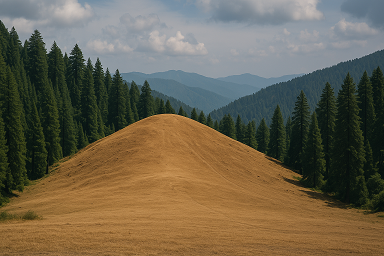By – Mohit Bangari
20 July 2025

Explore Himalaya With Me!!

Dhanaulti, a peaceful hill station in Uttarakhand’s Tehri Garhwal district, is mostly known for its lush green forests, apple orchards, and quiet environment. But in the middle of these thick forests, there lies a strange patch of land that has puzzled both locals and visitors for years. This is the Barren Hill of Dhanaulti — a hilltop where not a single tree grows. Even after multiple plantation drives, no plant seems to survive. Why is this land so different from the rest of the area?
In this article, I’ll share in detail about this mysterious barren patch — its location, possible scientific reasons, local legends, and the efforts made so far to restore vegetation.
This unusual land is located a few kilometers away from the main Dhanaulti town, near the famous Eco Park area. If you’re going towards the Surkanda Devi temple or Kanatal, you might come across it. From a distance, it looks just like any normal piece of hill, but once you reach, you’ll notice it’s oddly lifeless. While the surrounding forest is filled with deodar, oak, and rhododendron trees, this hill remains dry and dusty, with barely any grass.
Scientists and environmentalists have tried to understand the reason behind this strange land. Here are a few popular theories:
Some experts believe that the soil in that area lacks key nutrients like nitrogen, potassium, and phosphorus. Without these, trees cannot grow. Also, if the soil is highly acidic or alkaline, it creates an unhealthy environment for plant roots.
There’s a possibility that beneath the top layer of soil lies a thick rock or mineral deposit. This could stop roots from growing deep into the ground. Some believe there may be a high concentration of quartz or limestone, which affects plant growth.
This is a rare but interesting theory. Some people think that there might be an unusual geomagnetic field or natural radiation coming from underground. Such energy can interfere with plant growth. Similar types of places exist in other parts of the world too.
Water doesn’t stay in the soil in this region. It either runs off too quickly or doesn’t get absorbed. Without enough water, even the strongest saplings cannot survive.
This hill has not been ignored. Over the years, the Uttarakhand Forest Department, local NGOs, and environmental activists have tried several times to plant trees here. But strangely, even after watering, fencing, and caring, none of the trees grow beyond a few weeks or months. Most of them dry up, and the land returns to its barren look.
One official from the Dhanaulti Eco Park staff once said during a plantation drive:
“We plant here every year with hopes. But it’s like the land itself rejects the trees.”
In the hills, no mystery is complete without a local story. The villagers around Dhanaulti have their own explanations:
According to a common legend, a saint once meditated on this hill. He wanted complete silence and isolation. When woodcutters came to chop the trees near him, he got angry and cursed the land — that no tree shall ever grow again.
Some locals believe a battle took place here during the Gorkha invasions. Hundreds of soldiers died, and their blood cursed the land. They say the souls of the dead roam here at night.
A few old shepherds avoid grazing their cattle in this area. They believe the land is haunted. Many locals say they’ve felt an odd energy or sudden cold wind while walking near this patch.
These may sound superstitious, but such stories are a part of Himalayan culture and often carry symbolic meanings.
This strange spot has now become a curiosity for tourists. Many nature guides in Dhanaulti show this patch to visitors as a “mystery spot.” While some tourists take photos and move on, others get deeply interested and ask a lot of questions.
Still, this hill is not yet officially promoted as a mystery site, perhaps because the authorities don’t want to spread superstitions or fear. But honestly, it has potential to become an eco-tourism highlight if presented properly with facts and local stories.
Interestingly, Dhanaulti is not the only place with such strange land.
In Himachal Pradesh, near Kinnaur, there’s a “silent forest” patch where locals say no tree survives.
In Meghalaya, some parts of sacred groves also remain untouched even by weeds.
Globally, in Canada and Scotland, some forest lands show similar no-growth patterns due to strong magnetic fields.
If the mystery of this barren hill is to be solved, here are a few things that can help:
Proper Soil Testing: Detailed lab tests to understand exact composition and pH levels.
Magnetic Field Study: Using geomagnetic sensors to check for abnormal magnetic behavior.
Drone & Satellite Observation: To monitor long-term changes and understand how water flows in this area.
Mycorrhizal Plantation Technique: Using fungi-based root helpers that may boost tree survival.
Respecting Indigenous Wisdom: Along with science, listening to local elders may open new perspectives.
The Barren Hill of Dhanaulti remains a fascinating mix of nature, science, and culture. Whether it is because of rocky underground, magnetic fields, or ancient curses — we may never fully know. But one thing is sure: the mystery makes the place even more special. In a world full of answers, it’s nice to have a few unsolved puzzles that keep our imagination alive.
Next time you visit Dhanaulti, don’t just go for the views or cool weather. Take a small detour and visit this strange patch of land. Who knows, maybe you’ll feel the mystery in the air too.
🟢 You may also like to read:
You can also explore more on Himalayan treks like Darma Valley, Adi Kailash, and others on my website mohitbangari.com, where I share full guides, routes, permit tips and cultural info.
By – Mohit Bangari
20 July 2025
Do you know about Ramman festival of Salud-Dungra village? It’s one of the intangible world cultural heritage of India in UNESCO. You can read a detailed article on this topic here.


Explore Himalaya With Me!!